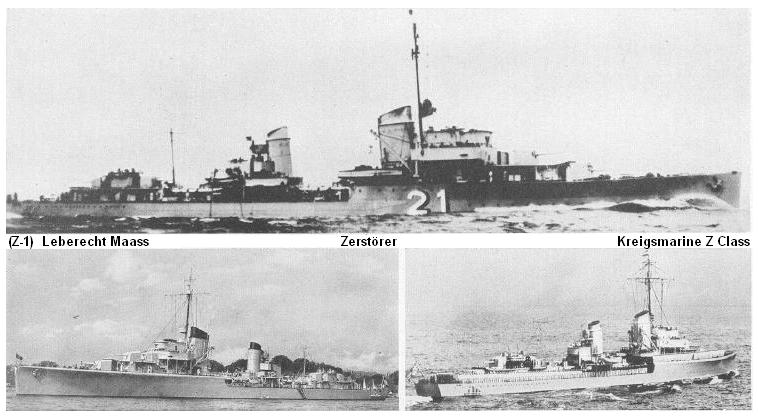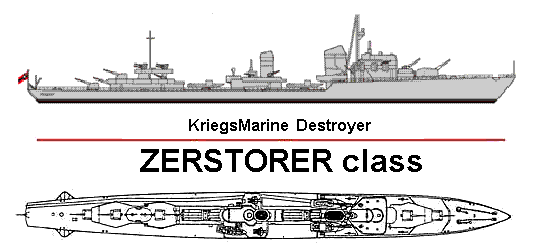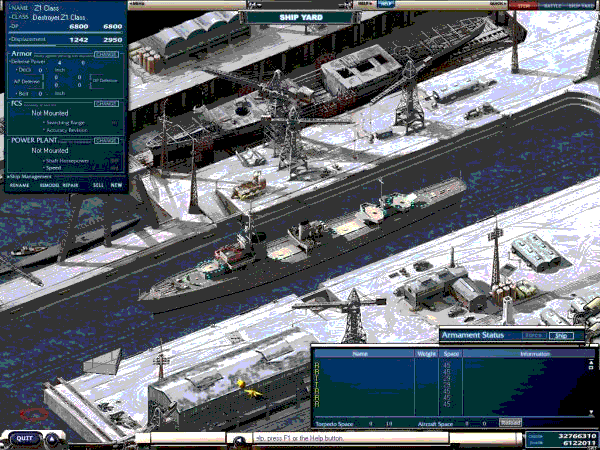The destroyers of the "Zerstörer 1934" class were the first four destroyers built by Germany after World War I. 
Kreigsmarine Destroyers - Z Class - Leberecht Maass (Z-1) ==========================================================================

Leberecht Maass (Z-1) was a Type 1934 destroyer in the German Kriegsmarine, named after Rear Admiral Leberecht Maass who commanded German forces in the Battle of Heligoland Bight in August 1914.
She was launched on 18 August 1935 at Deutsche Werke in Kiel and entered service on 14 January 1937. The ship displaced 3,156 tons, had a length of 119.3 m and a beam of 11.3 m, and could steam at 38.2 knots. The armament comprised five 12.7 cm guns in single turrets, four 3.7 cm AA guns, six 2 cm Anti-aircraft guns, and eight 53.3 cm torpedo tubes. The crew numbered about 325.
On 3 September 1939, Z-1 Leberecht Maass and Z-9 Wolfgang Zenker took part in an attack on the Polish ships Gryf and Wicher in Gdynia harbour, and Leberecht Maass was hit in a gun shield and suffered her first four war deaths (the German ships caused only minor damage to the Gryf). It is not clear if Leberecht Maass was hit by the Gryf or the Polish 152 mm coastal battery at Hel.
In early 1940, the ship was part of the 2nd Destroyer Flotilla in the North Sea. On 22 February 1940, Leberecht Maass and five other destroyers sailed for the Dogger Bank to intercept British fishing vessels (Operation Wikinger). En route, the flotilla was erroneously attacked by a Luftwaffe bomber. Leberecht Maass was hit by one bomb, lost steering and strayed into a British minefield. The ship hit a mine and broke in half, sinking with the loss of 282 of her crew. Only 60 were saved. During the rescue effort, Z-3 Max Schultz also hit a mine and sank with her entire crew.
This Zerstörer class of ships was the first German destroyer class were built after the end of World War I, laid down between October 1934 and January 1935. They were not very good ships. Built rapidly, they were too wet in heavy seas, which could make their forward guns unusable, there were structural weaknesses and machinery problems. The engines were newly designed high pressure turbines that promised much but disappointed once installed: maintenance was difficult and they caused excessive vibration. In addition, the class' range was limited (less than half of equivalent British ships) and they had limited magazine capacities (again half of the British equivalents), factors which contributed to the heavy German losses. Only one ship survived the war.
In the Allied intelligence manuals these ships were known as the Leberecht Maass class, after the first named ship. In German records they were always referred to as the Type 34 (Z1- to Z-4) and type 34A (Z-5 through Z-16). They were large, very powerful looking ships and were fast and heavily armed. They were in fact examples of the penalties of trying to do too much on a limited displacement. Their magnificent appearance concealed some serious design weaknesses and they were modified continuously in an effort to correct these shortcomings.
The class was constructed by several yards, with the first units laid down in 1934 and the last completed by 1939. The class comprised the bulk of destroyer forces available in the early days of the war and over half were lost in action.
The Kriegsmarine was greatly outnumbered in all classes of warships, thus the destroyer design philosophy was to produce small numbers of superior ships to try to offset the imbalance in numbers. Various machinery arrangements were tried, the common feature being very high force pressure turbines. Pressure levels were much higher than equivalent ships, even Japanese units, resulting in poor operational reliability.
The development of German torpedo boats and destroyers leading up to World War II was centered around the classic concept of using these types of ships in a manner similar to tactics used successfully in World War I. The key idea was to execute speedy torpedo attacks on other, bigger surface vessels such as was done during the Battle of Jutland in 1916. While the first new boats build after World War I were armed with an adequate mix of artillery and torpedo armament, those designs built in the mid 1930s were totally focused on torpedo attacks. When it became obvious that those kind of attacks were no longer possible during World War II, these ships proved to be almost useless for other operations.
Based on the same design principals as the torpedo boats, the Zerstörer ships showed some serious problems after completion, which were partly caused by the fast pace of naval construction programs after 1933. They were very bad seagoing ships, like most other German vessels they took on a high amount of water during heavy seas, making their forward artillery unusable. Further, they showed a structural weakness flaw since the hull started to bend in heavy seas and they were also burdened with heavy vibrations produced by their engines.
Their high pressure turbine engines caused many problems during operations, which were limited by the short range of those ships. The idea was to equip the ships with the newly designed high pressure turbines because this system seemed to have several advantages about normal turbine systems - at least on the paper. Test installations on land were very promising, but when installed on board on the destroyers, the engines rooms got very crowded making maintenance very difficult.
Like all German destroyers, they were equipped for mine laying, which was intensively used during the first months of the war.
Most ships of this class did not survive the second year of the war, two of them were even sunk by own bombers, but in their few operational months, they did some successful mining operations near the British coast.
All ships of this class suffered from a lack of stability due to the excessive top weight of their armament. They tended to ride low in the water at the bow and suffered from excessive spray at higher speeds. The original straight bow stem specified made this problem worse and all were fitted with a re-designed angled and flared bow. Strakes were fitted at various times to most units trying to reduce the spray, so excessive was teh problem that it even reached the bridge, and it made working the forward guns dangerous. The problem was reduced but never entirely solved. All German destroyers (including later construction) tended to be very wet ships in any sort of sea conditions.
The heavy armament was also an attempt to make up for the shortages in numbers of ships. They carried five 12.7cm/45 main guns (equivalent to the British 4.7 gun) and four 37mm AA and six 20mm AA. Eight 53.3cm torpedo tubes in two quadruple launchers were carried. Four depth charge throwers were fitted. Up to 60 mines could be carried.
After the construction of the new 15 cm gun in 1936, this gun was selected for the new class of destroyers, called the "Narvik" destroyers. With the biggest caliber used on board of the destroyer at this time, it was thought that those ships would have a tactical advantage over those with 12,7 cm guns.
With the 1936 model, for the first time on a German destroyer, the new ships would get a double turret mounted on the bow of the ship. Since the new turrets were not completed in time, the ships were commissioned with a single 15 cm gun instead and should have been refitted later.
After the start of World War II the construction of all new destroyer designs was canceled. To save material and increase the constructions time, some slight internal simplifications and engine modifications were done. The 15 cm gun turrets were taken from the already ordered O-Class battlecruisers.
The engines were also reworked and caused less trouble than those of the previous destroyers but at the end of the war the remaining ships showed some heavy corrosion in the boilers and tubes.
The general design was similar to the predecessors, but several effords were made to increase the seagoing capabilities. The single rudder was replaced by a twin rudder and the bow section was modified. But when sailing through heavy seas, it soon got obvious that the new bow section was ill designed, and the ships took over too much water. This problem even got worse after the new twin turrets were installed and it took a very long time until it grew clear that the new stern design was what had caused all the problems.
The development of the last German destroyer class of World War II was very confusing. Being first ordered as additional ships of the Zerstörer 1936 class, this later was changed to the Zerstörer 1938B design. Since development of these ships was stopped after the beginning of World War II, the ships would have been built as additional ships of the Zerstörer 1936A class.
As it became obvious that the 15 cm twin turret made the ships very unstable in heavy seas a modified version, the Zerstörer 1936 B was designed. Instead of the twin turret, the five projected ships got two single mounted guns and the Flak armament was increased. Besides this, the ships were very similar to those of the Zerstörer 1936A class.
Since they were only used in coastal waters and the Baltic Sea, the ships did not have the opportunity to prove if they were more seaworthy than their predecessors. After the start of World War II the construction of all new destroyers were canceled. Instead 12 additional ships of the Zerstörer 1936A class were ordered.
During the war, many of the surviving ships were refitted with additional Flak guns (Project name "Barbara") since the original armament proved to be inadequate.
Soon after the start of World War II it grew rapidly apparent that none of the existing German destroyers were adequately protected against air attack. Since the number of light Flak guns could not be increased, a new main armament for destroyers, capable of being used against both air and sea targets was called for.
Due to their slow building times and small numbers, German destroyers were very individual ships with considerable variation in equipment. In 1941 it was decided to attempt use of the new Luftwaffe 12,8 cm Flak 40 in twin mountings for a new class of destroyers. To explore this concept two ships were modified. Zerstörer 1936B designs were adapted to the new armament. They were laid down in 1942 but not completed before the war ended. Also,while four additional were ordered in 1943, none of them were ever started.
In 1937/38 the development of a big destroyer for Atlantic operation had started. Being about 50% bigger than all previous destroyers these ships would be equipped with a mixed propulsion system like the one used in Light Cruisers of the Leipzig or Köln Class: With diesel engines for long cruises and steam turbines for fast combat operations. To protect the ships, a light armor was projected to be adequate protection. Although the design was not very satisfying, 24 of these ships were ordered under the Z-Plan , 10 were to be built before1943, and another 14 would be completed by 1945. Three ships were actually ordered in 1939 but canceled in 1940 without being laid down. However, practical development of the big destroyers continued and led to the design of the Spähkreuzer.
=================================================================================
NB: The above text has been collected / excerpted / edited / mangled / tangled / re-compiled / etc ... from the following online sources :
KM - Destroyer Z-1 - wikipedia article #1
KM - Destroyer Z-1 - wikipedia article #2
KM - Destroyer Z-1 - smmlonline.com
KM - Destroyer Z-1 - www.german-navy.de

